Which House Do We Live In?
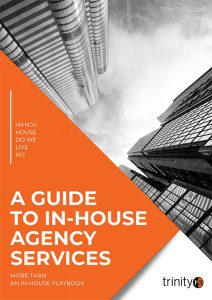
More than an In-House Playbook

The term ‘in-housing’ has been part of our industry for several years, and it’s fair to say that results have been varied. Some organisations have successfully integrated elements of creative ideation, production, or media buying services; some have tried and then reverted to an outsourced model; and some have found a balance in a hybrid approach, combining what they still need from their agencies with what they can manage in-house.
Agencies, too, have adapted to the changing landscape and are now more willing and capable of considering different servicing or scoping models tailored to their clients’ specific requirements or operations.
Just like everything else, in-housing presents both challenges and opportunities, pitfalls and peaks. At TrinityP3, with over twenty years of global experience in marketing management consulting, we’ve helped multinational corporations and local businesses alike navigate the complex process of agency relationship optimisation and marketing operations improvement. Our unique perspective—covering five continents and numerous industry sectors—has enabled us to identify the key success factors and common pitfalls of in-house agency models. This paper, grounded in our practical experience, aims to offer guidance and ideas to those contemplating in-housing their agency services.
This paper is particularly beneficial to:
- Executive Marketing & Brand Leaders: Obtain a comprehensive understanding of the strategic implications and potential ROI of in-housing.
- CMOs & Marketing Directors: Craft a clear roadmap for designing, implementing, and scaling an in-house agency.
- Procurement & Finance Directors: Gain detailed insights into cost analysis, value measurement, and risk mitigation approaches.
- In-House Agency Leads & Managers: Explore best practices for operational efficiency, talent management, and stakeholder engagement.
- Organisations at Any Stage of Their In-House Journey: From initial feasibility studies to mature operations aiming for optimal performance.
What’s Out There? The Landscape.
There’s no doubt that, in recent years, both marketers and agencies have faced unprecedented pressures. The pressure to keep up with technology, to integrate increasing amounts of data, to maximise ROAS and ROMI, to take on broader responsibilities, and to provide evidence that the marketing function is cost-effective and contributes to growth.
This environment has impacted marketing-agency relationships. While many remain remarkably resilient, the overall tendency to ‘blame the agency’ or ‘complain about the client’ is growing stronger. This is reflected in more pitches, shorter tenures, and feedback from both agencies and marketers about operational challenges in these partnerships.
Consequently, in recent times, in-house has gained popularity. At first glance, not having to pay agency overheads, eliminating agency management, and having dedicated staff working solely for your business with aligned goals and measurement frameworks can seem tempting.
However, as with most marketing choices, it’s rarely so straightforward. There’s an obvious benefit in internally meshing processes in a way that’s impossible for an external agency to match. But it’s not easy. Without a clear strategic vision, solid operational frameworks, and a commitment to ongoing optimisation, an in-house team can become underperforming, riddled with hidden costs, talent drain, and reduced creative impact.
We’ll consider in-housing in three phases:
Phase 1: Foundations – Strategic assessment and business case.
Phase 2: Implementation – Set-up and enablement.
Phase 3: Optimisation – Building for success.
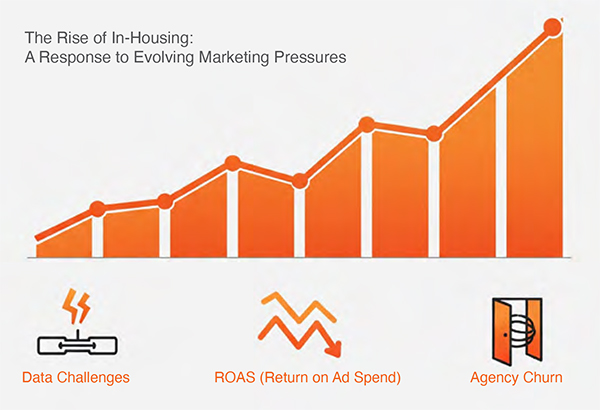
Phase 1: Foundations Strategic Assessment and Business Case.
The decision to establish or significantly expand an in-house agency must be based on thorough analysis, not just anecdotal evidence or knee-jerk cost-cutting. This phase focuses on building a solid business case that can withstand scrutiny and pave the way for real success.
Define Your “Why and What”: Articulating Strategic Imperatives & Quantifiable Objectives
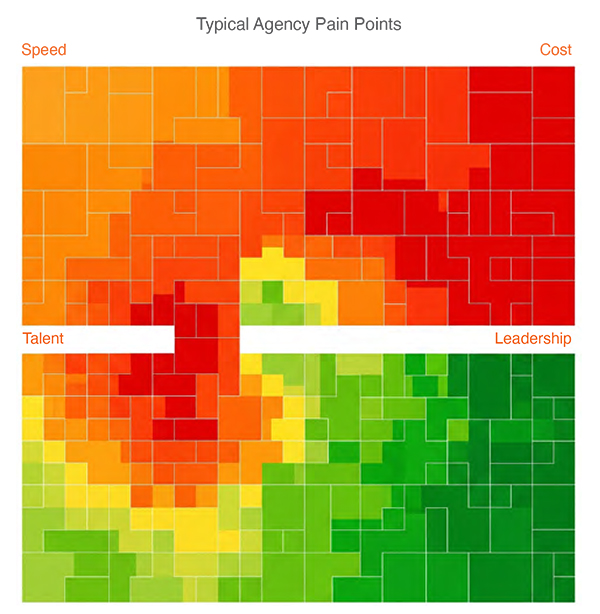
It’s important to remember that in-housing doesn’t have to be an all-or-nothing process. A phased or test-learn-evolve approach makes sense for clear reasons and can also be more effective in a business case, especially if your organisation is fairly risk-averse.
There could be influences, both internal and external, that make in-housing seem like a good idea.
Cutting out the white noise and conducting an in-depth audit of the agency or agencies under consideration as having in-housing potential enables clarity of focus on any areas of imbalance between marketing objectives and your perceived return on agency investment.
In general terms, an audit is necessary to articulate the following clearly:
- The accurate, objective current state of your agency relationships and operations, and the desired future state for marketing within your organisation.
- The resultant ‘opportunity gap’ between current and future states that could be filled by in-housing. It’s highly unlikely that an agency does everything wrong. In-housing is not about complete transformation, in this sense; it’s about providing a better fit for the current state, it’s about setting up for success or achievement of the future state, and it’s about identifying those gaps which only in-housing can really fill.
- The ‘effort in, reward out’ equation – is the identified opportunity gap big enough to justify the investment into in-housing?
To ascertain the opportunity gap, it’s best to adopt a Green/Amber/Red framework in audit to allow objectivity across what’s working well, what could be better, and critical areas of under-delivery in the current state.
It’s also necessary to objectively consider the desired future state in cultural and organisational terms. How well, in practice, is an in-house model going to work with your stakeholders? What cultural challenges might you encounter? Who’s going to be on board? Internal consultation in these areas, in addition to executive sponsorship, is critical to successful change management and onboarding of an in-house solution.
A current state audit can be challenging to drive from the inside, given the sensitivities involved (you’re asking your own people to discuss weaknesses/areas of challenge in their own roles, as well as those on the agency side they work directly with). A solution is to appoint third party consultation (TrinityP3 performs many independent operational and commercial assessments of incumbent agency-marketer relationships). What’s essential is to ensure that the opportunity gaps identified by an audit are:
- Evidence-based – via previous reviews, specific examples or similar.
- Trend-based – repeated occurrences of the same challenge
- Scope-based – is the problem actually within the agency’s scope of services to fix?
- Consultation-based – what are your people telling you? What is your agency telling you?
- Process-based – what steps have been taken to resolve the issue, over what time period? What KPIS or SMART goals are in place, if any?
- Priority based – on a scale of 1-10, how critical is the issue in overall terms?
- Objectively based – employing radical candour, what problems stem from the agency/s and what problems are of your own team’s creation?
Examples of agency-driven pain points that cause opportunity gaps to arise could be speed and agility-related (agency too slow, either to respond or to cluster and solve); knowledge-related (agency doesn’t know enough); commercial-related (too expensive or unwieldy); people-related (skillset gaps or relationship issues); leadership-related (lack of proactivity, follow-through, strategic initiative); output-related (good work is too hard to achieve, or not achieved); outcome-related (not seeing the necessary ROAS or ROMI).
On the ‘client side’, pain points might include a lack of information sharing with the agency/s, poor briefing, insufficient time allowance to complete tasks, scope creep, workflow prioritisation issues, avoidance of contact with agency leads, or other interpersonal challenges, along with a general, culturally ingrained disrespect for ‘agencies’ that manifests in negative behaviours towards them.
Building a weighted assessment rack tailored to your organisation, covering all identified pain points, would help clarify the level of need and the perceived benefits of transitioning to an in-housed model.
If the outcome of this assessment shows a strong case for in-housing, the next step is to consider the logistics and costs (both OPEX and CAPEX) involved in making the change.
Considering the Cost of In-Housing
A common misconception from an organisation tired of paying marked-up agency head-hour rates, inflated production costs or hidden media buying charges is that in-house automatically equals cheaper.
The truth is that hidden costs and underestimating complexity can rapidly diminish perceived savings.
In a nutshell, the agency model that has existed for decades, in many industries, is fundamentally based on the concept of ‘outsourcing expertise, to avoid internal overhead and remove internal skillset gaps.’
Objectively speaking, this idea is more accurate today than ever before. This is because of the increasing complexity of skillsets now held by agencies, which explains why most organisations prefer to bring things in-house gradually (e.g., handling part of creative production but not all; managing paid search and affiliates but avoiding programmatic trading or traditional media buying).
Of course, agency fees come with a profit, and therefore a higher base cost, attached (and rightly so; they’re businesses).
However, the investment involved in in-housing means that your organisation becomes responsible for the overheads related to headcount – covering everything from building space, payroll tax, healthcare responsibilities, superannuation, insurance, amenities, energy costs, IT expenses (hardware and, importantly, software – especially specialised software platforms, licences, or technologies needed in areas such as workflow management or ticketing, consumer research, design, media buying, and others), legal costs, paid vacation, training, and development, among others.
Another thing to consider is the internal management cost involved in embedding an in-house team and providing ongoing oversight. This isn’t just in terms of resource drain, but also opportunity cost (i.e. your management team working on management of the in-house agency, when it could be doing other things).
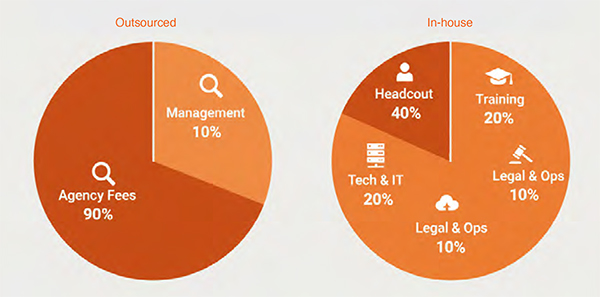
Furthermore, there is the cost and difficulty involved in recruiting the required talent. It is true to say that most corporate marketing teams work in very different environments, and in this context, both recruiting and retaining agency people over to ‘the client side’ can be fraught with challenges.
Finally, as with any business case involving investment in headcount, you need to consider team structure and required resourcing as a central part of your business case. When in-housing ‘agency services’, this can be challenging, given that there are likely to be agency resources working on your business that you will not be aware of, and sometimes will not be included on a retained resource plan (instead, the cost to the agency of this resource is taken up in overhead).
To overcome these challenges, there are several options:
- Hire consultants to identify and build a recommended structural and resourcing approach, tailored to your needs.
- Hire consultants offering a ‘fully managed’ in-housing service (which can involve a mix of in-house talent and offshore talent).
- Hire a knowledgeable leader ahead of the curve, with a remit to build the department from scratch.
- Undertake a phased transition and/or a hybrid model by negotiating with your incumbent agency and agreeing a plan whereby specific parts of service are in-housed, with external agency support continuing in oversight or in other areas.
The option you choose will inform the financial business case/projection plan you need to submit to your business. All have pros and cons attached, and you can, of course, tailor your solution in any way you choose; however, a summary of the most common models is listed below (these descriptors are based on advertising agency in-housing but can, of course, be applied to media agencies as required).
- Pure Production Hub:
- Focus: High-volume, tactical asset creation (e.g., social posts, banner ads, email graphics, simple video edits).
- Characteristics: Highly process-driven, emphasis on speed and cost efficiency, often junior to mid-level talent. Strategic direction comes from marketing teams or external agencies.
- Best For: Organisations with high content velocity needs and mature brand guidelines.
- Strategic Hub (Hybrid Model):
- Focus: Internal team handles strategic creative direction, brand guardianship, and potentially project management. Execution is often outsourced to a roster of specialised external agencies or freelancers.
- Characteristics: Senior creative and strategic talent in-house. Offers deep brand immersion without needing to scale full production capabilities.
- Best For: Brands where strategic oversight and brand consistency are paramount, but diverse execution needs make a full-service internal team impractical.
- Full-Service In-House Agency:
- Focus: Handles end-to-end campaign development, from strategy to execution across multiple channels.
- Characteristics: Significant investment in diverse talent (strategists, creatives, media planners, producers), complex operational structure. Requires strong internal “client” relationships and clear P&L accountability.
- Best For: Very large organisations with sustained, high-volume, complex marketing needs where deep internal knowledge provides a consistent competitive edge. Often functions as an independent business unit.
- Embedded vs. Centralised:
- Embedded: Small creative teams sit directly within brand or business units. Pros: Deep category knowledge, close collaboration. Cons: Potential for siloed work, inconsistent brand application across business units, and limited career progression.
- Centralised: A single in-house agency serves multiple brands/business units. Pros: Consistency, economies of scale, clear brand guardianship, diverse project exposure for talent. Cons: Can feel less responsive to individual brand needs, potential for internal “client” friction. A hybrid central model with embedded client service leads often works well.
Building the Business Case & Securing Cross-Functional Alignment
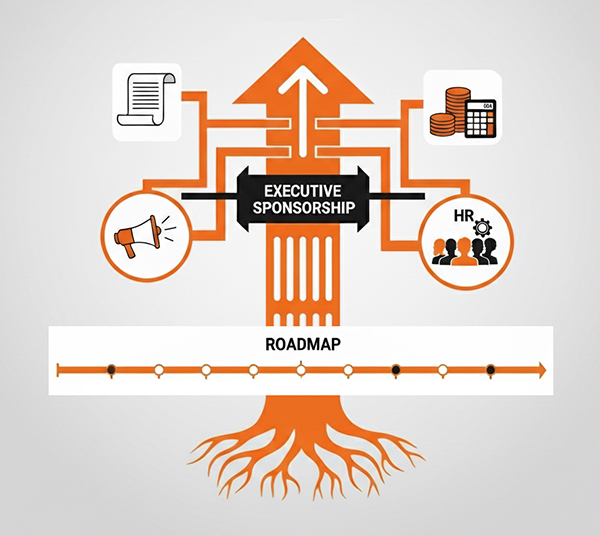
- The Business Case Narrative: Go beyond spreadsheets. Use the results of your audit to tell a story that highlights the strategic importance, measurable benefits, proposed solution, and risk mitigation. Include a detailed financial model (ROI, payback period, net present value).
- Early & Continuous Stakeholder Engagement:
- Marketing Leadership: Clearly explain how the in-house agency aligns with and supports broader marketing objectives and brand strategy.
- Finance: Emphasise cost transparency, ROI, and budget management. Tackle the “hidden costs’ early on.
- Procurement: Work together on managing vendors for external agencies, purchasing technology, and ensuring compliance. Make sure they understand the new internal “supplier” dynamic.
- HR: Essential for talent acquisition, salary benchmarking, career development, and performance management in creative roles. Their grasp of agency culture versus corporate culture is crucial.
- Legal: IP ownership, contract templates for freelancers, and compliance with advertising standards.
- IT: Infrastructure, software licensing, data security, and system integrations.
- Success Roadmap. Setting up in-house agencies can be complex. It’s crucial to manage expectations with a realistic planning roadmap that outlines how long it will take for the model to be fully operational.
- KPI Framework. Clear, concise, measurable (SMART) goals designed to achieve the future-state vision, with built-in review periods.
- Executive Sponsorship: This is non-negotiable. An in-house agency marks a major organisational change. Secure a senior executive champion who will advocate for the initiative, remove roadblocks, and ensure long-term commitment. Without this, your agency will struggle for legitimacy and resources.

Furthermore, there is the cost and difficulty involved in recruiting the required talent. It is true to say that most corporate marketing teams work in very different environments, and in this context, both recruiting and retaining agency people over to ‘the client side’ can be fraught with challenges.
Finally, as with any business case involving investment in headcount, you need to consider team structure and required resourcing as a central part of your business case. When in-housing ‘agency services’, this can be challenging, given that there are likely to be agency resources working on your business that you will not be aware of, and sometimes will not be included on a retained resource plan (instead, the cost to the agency of this resource is taken up in overhead).
To overcome these challenges, there are several options:
- Hire consultants to identify and build a recommended structural and resourcing approach, tailored to your needs.
- Hire consultants offering a ‘fully managed’ in-housing service (which can involve a mix of in-house talent and offshore talent).
- Hire a knowledgeable leader ahead of the curve, with a remit to build the department from scratch.
- Undertake a phased transition and/or a hybrid model by negotiating with your incumbent agency and agreeing a plan whereby specific parts of service are in-housed, with external agency support continuing in oversight or in other areas.
The option you choose will inform the financial business case/projection plan you need to submit to your business. All have pros and cons attached, and you can, of course, tailor your solution in any way you choose; however, a summary of the most common models is listed below (these descriptors are based on advertising agency in-housing but can, of course, be applied to media agencies as required).
- Pure Production Hub:
- Focus: High-volume, tactical asset creation (e.g., social posts, banner ads, email graphics, simple video edits).
- Characteristics: Highly process-driven, emphasis on speed and cost efficiency, often junior to mid-level talent. Strategic direction comes from marketing teams or external agencies.
- Best For: Organisations with high content velocity needs and mature brand guidelines.
- Strategic Hub (Hybrid Model):
- Focus: Internal team handles strategic creative direction, brand guardianship, and potentially project management. Execution is often outsourced to a roster of specialised external agencies or freelancers.
- Characteristics: Senior creative and strategic talent in-house. Offers deep brand immersion without needing to scale full production capabilities.
- Best For: Brands where strategic oversight and brand consistency are paramount, but diverse execution needs make a full-service internal team impractical.
- Full-Service In-House Agency:
- Focus: Handles end-to-end campaign development, from strategy to execution across multiple channels.
- Characteristics: Significant investment in diverse talent (strategists, creatives, media planners, producers), complex operational structure. Requires strong internal “client” relationships and clear P&L accountability.
- Best For: Very large organisations with sustained, high-volume, complex marketing needs where deep internal knowledge provides a consistent competitive edge. Often functions as an independent business unit.
- Embedded vs. Centralised:
- Embedded: Small creative teams sit directly within brand or business units. Pros: Deep category knowledge, close collaboration. Cons: Potential for siloed work, inconsistent brand application across business units, and limited career progression.
- Centralised: A single in-house agency serves multiple brands/business units. Pros: Consistency, economies of scale, clear brand guardianship, diverse project exposure for talent. Cons: Can feel less responsive to individual brand needs, potential for internal “client” friction. A hybrid central model with embedded client service leads often works well.
| Model | Focus | Characteristics | Best For |
| Pure Production Hub | High-volume, tactical asset creation (e.g., social posts, banner ads, email graphics, simple video edits). | Process-driven, speed & cost efficiency, junior–mid-level talent. Strategic direction from marketing teams or external agencies. | Organisations with high content velocity needs and mature brand guidelines. |
| Strategic Hub (Hybrid) | Internal team drives strategic direction, brand guardianship, and project management; execution outsourced to agencies/ freelancers. | Senior creative & strategic talent in-house; deep brand immersion; no need to scale production. | Brands prioritising strategy & brand consistency but needing flexible execution. |
| Full-Service In- House Agency | End-to-end campaign development: strategy + execution across channels. | Large, diverse talent pool (strategists, creatives, media, producers). Complex operations, internal client relationships, P&L accountability. | Very large organisations with sustained, complex marketing needs. |
| Model | Pros | Cons |
| Embedded: Small teams within business units. | Deep category knowledge, close collaboration. | Potential for siloed work, inconsistent brand application across business units, and limited career progression. |
| Centralised: Single agency serving multiple brands/units. | Consistency, economies of scale, diverse exposure. Cons: Less responsive, possible client friction. | Can feel less responsive to individual brand needs, potential for internal “client” friction. A hybrid central model with embedded client service leads often works well. |
Phase 2: Implementation & Enablement
The business case is approved, the strategy is on paper, the structure, scope and required resources are aligned; you now need to build the reality.
Organisational Structure & Talent Strategy
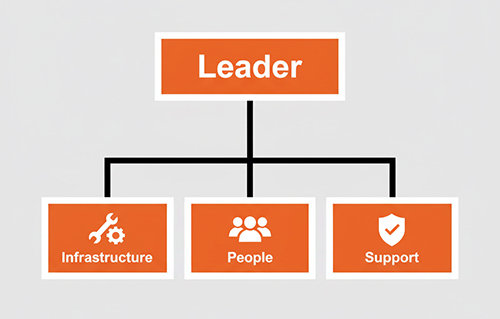
This section assumes you already have a leader for your in-house function—someone with enough experience to collaborate with you on what follows, maybe from the ground up.
If you don’t have that person – stop here and hire them! An experienced leader with the necessary subject matter expertise, the ability to navigate your business, and a build mindset is essential.
When you have your leader, that leader will need three things:
- Infrastructure, or the ability to procure infrastructure. Think everything from desks/space, through to tools, technology, licenses, IT equipment – the tools of the trade.
- People. It’s worth noting that recruitment of talent is probably the single most challenging part of the in-housing journey. The most likely source of talent is agency people, who are a different breed from corporate marketing people.
- Support. Never expect an individual, no matter how talented, to stand alone in the development of an in-house function. Without a clear mandate and support, they will fail.
Infrastructure
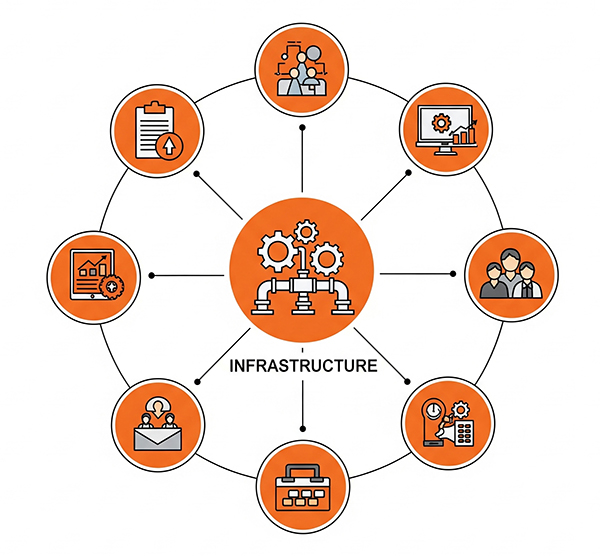
For creative/advertising agency functions, the right MarTech stack empowers efficiency, collaboration, and data-driven decisions. As a general rule, you should also prioritise tools that can integrate (e.g., DAM with your PMS, creative suite with DAM) to create seamless workflows and avoid data silos.
The infrastructure required for in-house agencies (creative or media) includes, but is not limited to:
- Core Creative Tools: Adobe Creative Cloud (Photoshop, Illustrator, InDesign, Premiere Pro, After Effects), Figma, Sketch.
- Productivity & Project Management: Workfront (enterprise-grade), Asana, Monday.com, Jira (for agile teams). Crucially, these tools need to be accepted and used where necessary by internal stakeholders, bombarding the in-housed agency with jobs.
- Digital Asset Management (DAM): Bynder, Widen Collective, Brandfolder, Adobe Experience Manager Assets. Crucial for organising, finding, and distributing creative assets efficiently.
- Communication & Collaboration: Slack, Microsoft Teams, Zoom.
- Digital Media Trading: Accounts set up to enable programmatic trading, search engine marketing, paid social media, campaign builds
- Measurement & Analytics: Google Analytics 4, Adobe Analytics, specialised platforms for implementation and tracking of social media, email marketing, or paid media.
- Research Licences/Platforms: competitive research such as Nielsen; consumer insight panels such as Roy Morgan
- Financial Management: Financial back-end platforms to manage direct media trading with vendors
- AI Augmentation: Explore AI tools that enhance creative output, not replace it:
- AI Copywriting Assistants: For initial drafts, headlines, variations (e.g., Jasper, Copy.ai).
- AI Image Generation: For mood boards, quick concepts, stock image alternatives (e.g., Midjourney, DALL-E 3).
- AI Video Editing: For transcription, basic cuts, or content repurposing.
- Predictive Analytics: To inform creative strategy.
people
If the most likely source of talent for an in-house agency is ‘agency people’, it’s worth trying to think about what the prospect of ‘moving in-house’ could look like to them.
An agency person being asked to move to an in-house role will likely consider some or all of the following when weighing up between ‘agency’ and ‘in-house’:
- Salary, benefits and career progression.
- Working on one piece of business versus working on many pieces of business
- The benefit of greater stability compared to the loss of a more competitive environment (for example, being involved in pitching)
- The generally more hierarchical structure of a corporation, versus the typically flatter structure of an agency
- The cultural differences between agencies and in-house teams are often seen as agencies being ‘younger and looser’ compared to an ‘older, more regimented’ corporate culture.
It is therefore critical to establish a talent strategy, either via the experience of your in-housed leader or via a recruitment consultant specialising in hiring for the skillsets you require. The talent strategy should include the following:
- Detailed Org Chart & Job Descriptions: Define every role, reporting line, and key responsibility. This brings clarity and avoids overlap.
- Design onboarding materials: playbook, manual, or similar, to help new employees understand the processes (or explain how processes will be developed).
- Consider Cultural Build: Foster a creative, collaborative environment within the corporate structure. Dedicate specific creative spaces.
- Compensation: Ensure salaries are competitive by benchmarking against both agency and corporate roles.
- Career Pathways: How can a designer grow into a CD? How can a project manager become a team lead? Offer professional development, mentorship, and opportunities to work on diverse projects.
- Performance Reviews: Balance traditional corporate KPIs with creative output and innovation metrics.
- Recruitment ‘Pitch’: Be definitive about all of the above when talking to potential candidates. Motivate them with the vision.
Support
Too often, corporate structures are not designed to accommodate profound change, and creating an in-house agency represents a significant shift in operations and culture.
Internal perceptions of ‘agency people’, or how an in-house agency
Your in-house agency lead is going to need support. Ensure that this person has:
- Proper mandate, remit and authority to carry out that remit
- Facilitation within your organisation involves meeting the right people to initiate the right workstreams, such as inter-departmental process development.
- KPIs – which are clear and reasonable.
- Regular contact – for progress updates, challenges or opportunities
Legal & Compliance Frameworks – Protecting Your Brand & Business
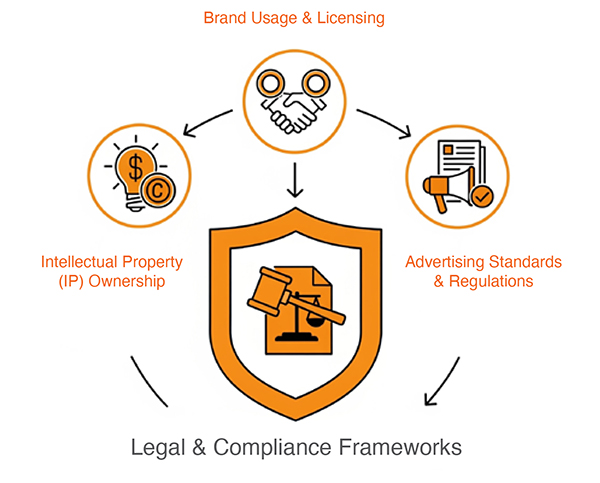
- Intellectual Property (IP) Ownership:
- Clearly define that all work created by in-house employees (within their scope of employment) belongs to the company.
- For freelancers, ensure robust contracts explicitly transfer all IP rights to your organisation.
- Brand Usage & Licensing:
- Strict guidelines for logo usage, brand colours, fonts, imagery, and tone of voice.
- Management of licences for stock photography, music, and third-party software.
- Advertising Standards & Regulations:
- Ensure all creative outputs comply with local and international advertising laws, consumer protection acts, and industry-specific regulations (e.g., healthcare, financial services).
- Data privacy compliance (GDPR, CCPA, APP in Australia) for any campaigns involving personal data.
Phase 3: Optimisation – Building For Success.
You’ve completed phases one and two. You’ve hired your people, and it’s day one with a whole team in place. What happens now?
It’s unlikely to be as straightforward as that; roles will take time, teams will need time to settle in, and adjustments to a new reality for everyone will have to be made. But never forget that, as a function so heavily reliant on human IP, an in-house agency is a living entity. Without ongoing monitoring, evaluation, and adaptation, it will stagnate. So, you need to foster a culture of excellence and accountability.
Defining Key Performance Indicators (KPIs) – Beyond Vanity Metrics
KPIs must align with the initial objectives set in Phase 1 and show clear value. Additionally, they should naturally align with your broader business; the more your in-house agency operates in isolation, the more it will be perceived as such, which, in our experience, is not the best approach for success.
Some examples of KPIs are provided below, noting that this serves as a somewhat of a ‘laundry list’ for consideration. Our recommendation is that any KPI framework should be clear, easy to engage with and measure, based on aligned values, and where possible or at least partly, rooted in outcomes (business performance) rather than inputs (cost).
- Outcomes
- Measured attribution of marketing/advertising activity on sales, enquiries, leads or similar metrics
- Brand saliency, awareness or similar markers
- ROMI
- ROAS
- Productivity & Output:
- Number of completed projects/assets per FTE.
- Utilisation Rate: Percentage of billable/productive time vs. total time (for cost analysis).
- Throughput: Number of items completed in a specific time period.
- Efficiency & Turnaround:
- Average time from brief submission to final asset delivery.
- Rework Rate: Percentage of projects requiring significant revisions after initial delivery.
- Cycle Time: Time taken for specific recurring tasks.
- Quality & Effectiveness:
- Brief clarity and adherence.
- Creative quality and strategic effectiveness.
- Timeliness and responsiveness.
- Overall service.
- Brand Consistency Score (if quantifiable).
- Creative Impact: Link creative performance to marketing outcomes (e.g., A/B test results, engagement rates, click-through rates, conversion rates).
- Financial Performance:
- Actual internal cost per asset/project vs. external benchmark
- Cost savings achieved vs. initial projections.
- Return on Investment (ROI) of the in-house agency.
- Talent & Culture:
- Employee Retention Rate (especially compared to industry benchmarks).
- Employee Engagement Scores.
- Professional Development Hours/Spend per employee.
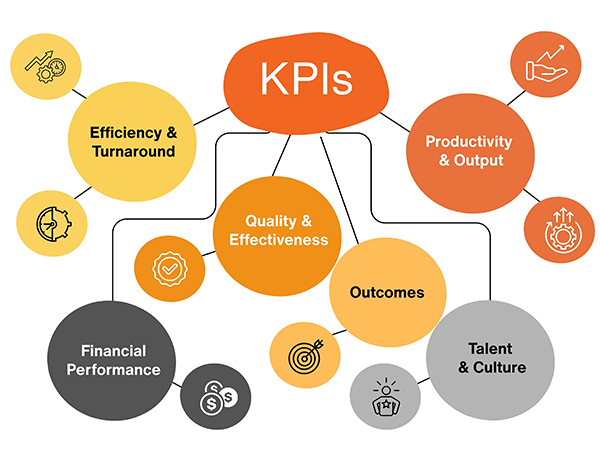
Measurement & Reporting Cadence – The Data-Driven Narrative
An in-house agency is often a new entity within an organisation. Naturally, this can bring some trepidation, scepticism, or, when it comes to making cuts, a ‘last in, first out’ mentality.
Therefore, it’s always wise to keep your C-Suite in the loop; transparency and regular reporting are essential for maintaining support and driving improvements.
- Executive Dashboards: High-level, visual dashboards for leadership focused on key strategic KPIs (e.g., ROI, strategic impact, overall efficiency).
- Operational Reports: Detailed reports for the in-house agency lead focusing on productivity, workflow bottlenecks, and resource allocation.
- Client Reports: Share relevant KPIs with internal clients to demonstrate value and manage expectations.
- Regular Review Meetings: Monthly or quarterly meetings with marketing leadership, finance, and procurement to discuss performance, challenges, and future strategic alignment.
Stakeholder Feedback & Service Improvement – Listening & Adapting
The in-house agency acts as a service provider. This can take some time to get used to. However, the ideal approach should be an agency mindset, with an additional advantage; the enhanced knowledge, focus, and expertise that being in-housed delivers to the entire operation.
To make this benefit real, it is crucial to foster and sustain a strong working relationship between the in-house agency and other internal stakeholders. Stakeholders need to recognise the potential benefits and communicate effectively with the agency; however, it is also important to treat internal clients with the same professionalism and responsiveness as a reputable external agency would.
- Formal Feedback Mechanism: While you may opt to use the current internal structure, experience shows that it’s preferable to engage a specialist consultancy like TrinityP3’s Evalu8ing™. It’s a systematic, objective tool specifically designed for marketing-agency relationships, used for gathering client feedback after each major project. This structured data is far more valuable than random emails.
- Quarterly Business Reviews (QBRs): proactive meetings with key internal clients to review past projects, discuss upcoming needs, identify potential issues, and strategise for future collaboration.
- Internal Client Councils: Form a small, representative team of internal clients to give ongoing strategic input and feedback on the in-house agency’s direction and services.
- Actionable Insights: Turn feedback into clear action plans for process improvements, training, or resource adjustments. Relay these changes back to clients.
Integration with External Agencies & The Broader Ecosystem – Orchestrating the Roster
As we’ve mentioned previously, the in-house agency should not exist in a silo. But this doesn’t stop at your internal walls. The in-house agency is a critical component of your overall agency roster and should be engaged as such.
Other agencies in your roster should be –
- Communicated with regarding change and vision
- Kept in the loop with development
- Given the opportunity to facilitate leadership and operational connections with the in-house agency
- Be completely clear about their role, versus the role of the in-house agency and how the two intersect.
There are several steps you can take to achieve this position.
- Clear Roster Definition: Beyond “in-house vs. external,” specify particular roles and responsibilities for each agency on your roster. Who is the lead agency? Who manages strategic branding? Who oversees media? Who is responsible for specific tactical production?
- Seamless Workflow Handovers: Set clear protocols for quick hand-offs, sharing assets, and communication between your in-house team and external agencies to keep campaigns cohesive.
- Collaborative Planning: Foster joint planning sessions where appropriate, enabling in-house and external teams to contribute to strategy and creative ideation.
- Avoid Duplication: Proactively control scope to ensure that both internal and external teams do not duplicate tasks, which wastes resources and leads to conflict.
- Gatekeeping: Establish a straightforward process or “triage” function that determines whether the project is best suited for the in-house team, an external specialist agency, or the lead creative agency, based on criteria like complexity, scale, specialisation, and cost.
- Overflow: What is the protocol for handling overflow work? If the in-house team needs overflow assistance, which other agencies should take it on? How will that agency be compensated for accepting overflow work?
Risk Management – Proactive Safeguards for Long-Term Viability
The challenge associated with employing talent to work in an in-house agency was outlined in a previous section. Just as challenging will be staff churn, as those who came in become disillusioned and seek a ‘jump-back’ to agency-land.
Furthermore, one of the main challenges facing an in-house agency is the myopia it can create. When everyone operates under the same roof, the lack of external stimulus—usually provided by an external agency—can lead to stagnant thinking or application and a fallback into a ‘this is how we do it’ mentality. This mindset may also develop if internal stakeholders adopt a command-and-control approach to managing the relationship.
With this in mind, it pays to anticipate and tackle potential challenges early, preventing them from derailing your in-house agency.
- Talent Burnout & Stagnation:
- Proactive Workload Management: Ensure that capacity is monitored, that jobs are correctly prioritised, and that over-allocation is prevented.
- Professional Development: Allocate budget for and promote ongoing learning, skill enhancement, and engagement with external industry trends and creative inspiration. Proactively encourage in-house agency staff to seek external stimuli (as part of their role, not ‘in their spare time’).
- Creative Challenges: Make sure the team has opportunities to work on exciting, creatively demanding projects, not just routine production.
- External Exposure: Support attendance at industry events, awards shows, and even short sabbaticals to external agencies where possible. Incorporate external creative reviews, promote outside perspectives, rotate external creative talent for specific projects, and ensure internal political agendas do not solely influence the team.
- Regularly reassess the business case, showcase ongoing ROI, and advocate for essential resources.
- Lack of Internal Client Respect/Utilisation:
- Beyond the initial consultation, align and establish the approach of how we operate, proactively promote the in-house agency’s capabilities to internal stakeholders, consistently deliver high-quality work, and demonstrate value through tangible results and positive feedback.
An In-House Agency can be Highly Effective – If Set Up For Success.
A successful in-house agency is more than just a cost centre; it is a strategic asset that provides a competitive edge through exceptional brand expertise, increased agility, and ultimately, improved marketing effectiveness. It reflects an organisation’s dedication to innovation and efficiency in its most vital function: engaging with its customers.
However, reaching this level requires a disciplined, data-driven, and proactive approach. It calls for clear leadership vision, careful planning, strong operational frameworks, and ongoing commitment to review and improvement. It is a journey of change, not a one-off project.
At TrinityP3, we are not just consultants; we are experienced industry practitioners focused solely on marketing and agencies, collaborating with you to analyse complexities, identify opportunities, and implement sustainable solutions.
We can help you gain the clarity and confidence needed to make informed decisions and improve your marketing operations.
Don’t let the pitfalls of poor planning or execution overshadow the potential of in-housing. Use our proven expertise to ensure your in-house agency succeeds, becoming a strong driver of creativity, efficiency, and ongoing business growth.
Ready to embark on a truly optimised in-house agency journey?
Contact TrinityP3 for a confidential strategic discussion and needs assessment.

